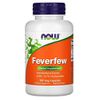Feverfew
Other Names: Altamisa, Bachelor's Buttons, Chrysanthème Matricaire, Chrysanthemum parthenium, Chrysanthemum praealtum, Featerfoiul, Featherfew, Featherfoil, Flirtwort Midsummer Daisy, Grande Camomille, Leucanthemum parthenium, Matricaria, Matricaria eximia, Matricaria parthenium, Partenelle, Pyrèthre Doré, Pyrèthre Mousse, Pyrethrum parthenium, Santa Maria, Tanaceti Parthenii, Tanacetum parthenium, Tanaisie Commune, Moederkruid, أقحوان زهرة الذهب, 短舌匹菊
Feverfew is a herb. The leaves are used to make medicine.
The feverfew herb has an appearance similar to a daisy and is actually from the daisy and sunflower family. It grows about 2 feet high and has the scientific name of parthenium. It is believed this name was derived from the herb being used to treat someone who had fallen from the Parthenon in Athens, thus saving their life.
Special Precautions of Feverfew
- Pregnancy and breast-feeding: Feverfew is POSSIBLY UNSAFE when taken during pregnancy. There is concern that it might cause early contractions and miscarriage. Don’t use feverfew if you are pregnant. The safety of feverfew during breast-feeding isn’t known. It’s best to avoid using feverfew if you are breast-feeding.
- Possible feverfew side effects are numerous, although not serious. Flatulence, diarrhea, and vomiting are among the list. Also a small number of people who have chewed the herb have reported developing mouth ulcers.
- Allergic reactions have been reported after the use of this herb. People who suffer allergies from chamomile or ragweed should possibly avoid use of feverfew.
- As feverfew could possibly increase the tendency to bleed, anyone taking blood thinning medications such as warfarin or aspirin should consult a medical practitioner before taking the feverfew herb supplement.
- Feverfew is not recommended for use on children under the age of two. Doses for those two years and older should be adjusted according to bodyweight. Professional advice is highly recommended to ensure correct dosages are given.
- When using feverfew for migraine relief, it is worth noting that it could take around four weeks for the herb to start to work, but it should help to lessen the frequency and severity of migraine attacks. If there is no improvement to symptoms or if the symptoms or frequency increase, seek medical advice immediately.
The benefits of Feverfew are
- In ancient Greece, feverfew was used to reduce swelling and to ease menstrual cramps.
- Today it is more commonly used to treat mild migraine headaches, as the feverfew herb contains parthenolide, which helps prevent blood vessels dilating. Acute migraine suffers may benefit from the use of this herb, but should always consult their doctor before doing so.
- Feverfew has many health benefits apart from giving relief to migraine sufferers. As the name suggests, it also helps ease the symptoms of fevers and lessen rheumatic pain.
- Although feverfew does have anti-inflammatory properties, it has not been proven in the treatment of arthritis.
- Pancreatic Cancer : In a clinical study published in the April 2005 issue of Molecular Cancer Therapies, researchers found that parthenolide from feverfew inhibited the growth of pancreatic cancer cells, and also contributed to the efficacy of a nonsteroidal anti-inflammatory drug in further helping suppress cancer cell growth. Researchers noted that this provided preclinical support for a combined chemotherapeutic approach in the treatment of pancreatic cancer. However, the subject of feverfew's ability to protect against cancer is still being studied.
- Leukemia : A study from the Rochester University in New York put the spotlight squarely on this herb. Researchers were shocked to discover that feverfew was better at killing leukemia cells than cytarabine. Parthenolide, the active ingredient in feverfew, has been fast-tracked by the Federal Drug Administration (FDA).
- Parthenolide is confirmed to be a cancer stem cell killer. Cancer stem cells are largely responsible for the failure of conventional cancer treatment.
- Feverfew can inhibit the formation of inflammation-causing prostaglandins, according to Drugs.com, a drug information website that provides peer-reviewed information to consumers. The website notes that feverfew has traditionally been used to treat arthritis and other inflammatory diseases such as psoriasis, as well as to lower fevers and reduce coughs.
- Source of melatonin


